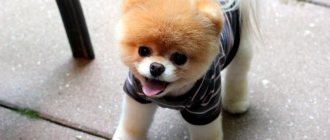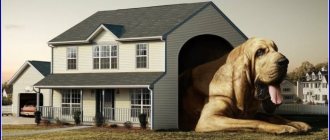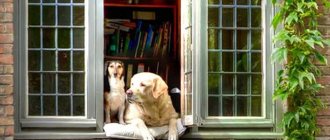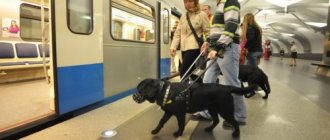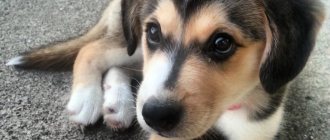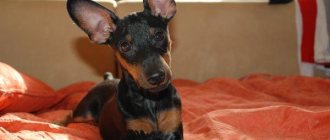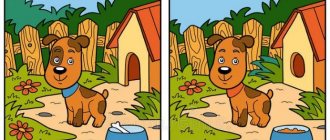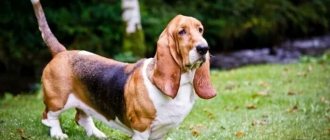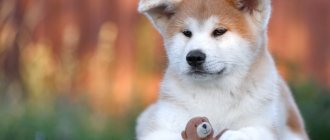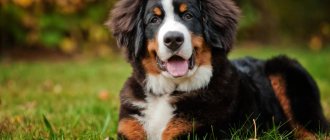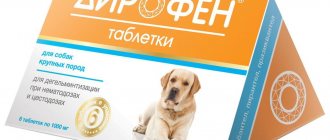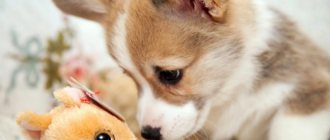Home » Dog Breeds
Let's face it, too many people decide they want a cute little adorable dog to love and care for. They spend a huge amount of time and money to choose that perfect dog, but after a couple of months, when the effect of novelty wears off, the animal is left without attention, and at the same time comes the understanding that having a dog is work.
We just want to go up to such people, shake them and shout: “A dog is not a decoration for the lawn or a trinket for the house!” In addition to the basic needs - water, food and a place to sleep - the dog needs attention, affection, emotions, grooming, and physical activity.
For those who still want to get a dog, but don’t want to walk it 30 minutes a day, spend time and money on training, or take it to the groomer every week, we offer this list of easy-to-own dogs. We understand that there are people who, for whatever reason, are physically unable to walk their dog every day, but still need a companion. In that case, just ignore the word “lazy” in the title of the article and continue reading.
Note: We are not at all advocating ignoring any animal or neglecting its needs—we just ask that you do not get an energetic Border Collie if just walking to the car makes you irritated. And you shouldn’t adopt a Shih Tzu that requires constant care if you’re too lazy to comb your own hair. Take home a dog who, for a tenth of the care, will love you just as much.
- 2 Japanese Chin
- 3 Greyhound
- 4 Bullmastiff
- 5 Pug
- 6 Glen of Imaal Terrier
- 7 Bulldog
- 8 Pagle
- 9 Rat Terrier (Ratcatcher Terrier)
- 10 Chihuahua
Bolognese (French lap dog)
The breed is believed to have originated in southern Italy from dogs like the Bichon Frize. Until the early 19th century, bolognese were popular as companions among the royal court and nobility of Spain. This is a robust breed of toy companion dog without any of the typical genetic problems. Consider the needs of Bolognese:
The space requirement is minimal. The Bolognese will be a great dog for your apartment. This indoor and decorative breed has a strong build and weighs 3-6 kg - this is comparable to the size of a baby.
You can find out about other dog breeds that are great for keeping in an apartment here:
The need for physical activity is minimal. Bologneses are playful, but not very active. Periodic, but not regular walks are suitable for them.
The need for training is minimal. These dogs are very intelligent and easy to train. They can be shy around strangers, but are great with children and other animals.
The need for grooming is moderate. This is a long-haired breed with white fur.
It mats easily but doesn't shed much and is considered hypoallergenic.
Dogs that do not require special maintenance and care
Unpretentious dog breeds are perfect for beginners. To prevent your favorite fluffy ball from becoming a thing that gets in the way, you need to clearly understand that the initial joy of the purchase will pass in a month, and you will have to live with the new member of the team for 13-15 years.
Even dogs that do not require special living conditions will not be able to obtain the required amount of food without the help of their owner. Proper care and attention are two fundamental factors in the relationship between breeder and pet.
In order not to overwork yourself later, when choosing a puppy, it is important to consider the following factors:
- Dimensions of the dog. The larger the dog, the more room it needs to maneuver.
Not every small dog is suitable for living in an apartment. The character and temperament of the animal play a special role. For example, cocker spaniels, without room to run around, can, out of boredom, damage household furniture and drop objects that don’t fit well on the floor. And the big mastiff calmly lies on the lounger all day. Lazy breeds such as the pug and English bulldog will behave in a similar way.
- Frequency of coat renewal. In order not to remove pet hair from carpets and furniture every day, it is better for apartment dwellers to choose a representative of a low-shedding breed.
- Dogs with saggy lips are prone to excessive salivation. If the breeder does not like to wash the floor and furniture stained as a result of the display of joy every hour, you need to select a “non-slobbering” pet.
- Neighborhood with other animals plays an important role. Decorative breeds such as the dachshund or fox terrier were originally used as hunting dogs. Because of their unconfused instinct, it is better to hide cats and domestic rabbits away from them.
- Owning miniature breeds such as Chihuahuas, French lap dogs, and toy terriers should be done with caution in families with children. By showing excessive love and care, kids can harm the pet.
- The owner’s lifestyle is also taken into account. If the breeder has a busy work schedule and does not have a minute left to communicate with the pet, it is better to refrain from buying a puppy. A dog that spends its days alone will develop behavioral problems over time.
Taking these recommendations into account, you can choose the most suitable breeds for living in an apartment.
For apartment
With the appearance of a dog, the smell of a dog will spread into the room, the furniture will get dirty, and the dog will always get in the way. This is what most residents of multi-storey buildings think. In fact, everything is much better.
Today, many hypoallergenic breeds have been bred that do not shed or emit odor. A dog of medium or small size will successfully live in any apartment. A list of the most unpretentious animals is presented below.
Papillon
The name of the breed, received by the dogs for the special shape of their ears, is translated from French as butterfly. The second name is continental toy spaniel.
The owner of the continental receives a cheerful dog, capable of enjoying life 24 hours a day and constantly following him wherever he goes. The activity of Papillons is off the charts. Animals love physical activity and outdoor games.
Japanese Chin
The Japanese Chin (also known as the Japanese Spaniel) was actually bred in China and brought to Japan as a gift from the Emperor. This breed became very popular among the Japanese nobility, and Japanese Chins were first brought to Europe in the early 19th century.
The space requirement is minimal. These small dogs weigh only 1.8-3.2 kg and their size barely reaches 30 cm.
If you are interested in other small dog breeds, we recommend reading the article
The need for training is minimal. Japanese Chins are intelligent, quiet and reserved dogs. They get along well with almost everyone, including strangers, children and other animals. They are also very aware of their surroundings.
The need for physical activity is minimal. These dogs seem to be created to sit on their owners' laps. In addition, due to their shortened muzzle, excessive exercise can lead to breathing and heart problems. Periodic short walks are ideal.
The need for grooming is moderate. The coat of the Japanese Chin requires regular brushing to keep it shiny and the dog to look well-groomed. Small shedding occurs throughout the year, but without a specific odor.
Disadvantages: difficult to train during the first 4 months of life. Possible health problems include: kneecap displacement, heart disease, back disease, cataracts.
Features of caring for decorative pets
Small dog breeds are easy to care for. The main condition is to keep it indoors and not outside. As a rule, such pets are very sensitive to drafts, cold and heat.
Basic rules of care:
- regular hygiene of the oral cavity, ears, eyes, nail trimming; to clean your pet’s teeth, you can periodically pamper your pet with special bones;
- regular coat care, especially for long-haired dogs, whose hair is prone to matting, daily brushing with a soft brush, once every 1-2 months with a hard one;
- bathing once every 3-4 months with special products; frequent water procedures can damage the pet’s coat and skin;
- smooth-haired dogs and pets with undercoat do not need a haircut; long-haired dogs should have a hygienic haircut every 1-2 months;
- regular walking: half an hour to an hour every day is quite enough; in cold weather, pets must be dressed in special clothing; in hot weather, smooth-haired animals must be smeared with sunscreen;
- feeding premium food or higher.
I am the proud owner of a Bichon Frize dog. She has been living with us for two years. I have never had and never have any problems with this living toy. The dog is very active and friendly, and enjoys playing with my four-year-old daughter. The only negative is that he cannot stand loneliness. It is almost impossible to leave her alone at home, even for a short time. In this regard, I began to take her with me to work, where I equipped her with a sleeping and dining area. The pet has become a favorite not only of our family, but also of my colleagues and friends. He is ready to play all the time and with everyone.
Greyhound
Greyhound dog in the list of ten best dogs for lazy owners?! Yeah, live and learn. Yes, greyhounds are very fast over short distances, but their energy does not last long. In fact, for their unusual combination of high speed and love of lounging on their pillows, they were even nicknamed “high-speed lazy people” or “sofa potatoes.” Greyhounds have been living and hunting with humans for a very long time; mentions of them are found even among the ancient Egyptians and Greeks. What do greyhounds need for a happy life?
The space requirement is small. Yes, this is a really large breed (height is approximately 70 cm and weight is 26-40 kg), but these dogs also feel comfortable in small spaces. Generally, Greyhounds are quiet, gentle animals and are more suitable as an apartment dog than smaller, more active breeds.
The need for training is rather small. Greyhounds are quite obedient and get along well with strangers, school-age children, and other dogs. You may have to train them to behave well around small children and small animals.
The need for physical activity is low to moderate. Yes, Greyhounds are excellent sprinters and enjoy running, but they don't need regular exercise. Walking 20-30 minutes every day will help older dogs stay healthy.
The need for grooming is small. Greyhounds have short, soft fur and no undercoat. These dogs are suitable for people with allergies.
Disadvantages: Increased skin sensitivity and sensitivity to extreme temperatures.
More information about greyhounds:
Who are these breeds suitable for?
A dog for lazy owners is the choice of those who would really like to have a barking friend, but do not have the opportunity or desire to pay much attention to caring for him. These breeds are suitable in the following cases:
- for older people who can no longer spend long periods of time on walks, are unable to run or frolic with their puppy;
- busy people, those who do not have time to regularly care for their pet’s fur;
- persons with disabilities. A dog is a great way to improve your mood. In addition, it has been proven that communication with these animals has a beneficial effect on health. Therefore, disability is not a reason to give up your pet; the most important thing is to choose the right breed.
The owner and pet must certainly have similar temperaments
Note! Among the “lazy” there are good hunters and watchmen, so the dog will become not only a pet, but also an assistant.
Bullmastiff
Yes, the Bullmastiff is a very large breed of dog, but they are completely unpretentious. This powerful guard breed was developed in the mid-19th century after mixing the English Mastiff with the Old English Bulldog. The purpose of bullmastiffs was not to attack an attacker, but to stand in front of him or knock him down and hold him. For their size they are really inactive. They need:
The space requirement is rather small. Due to their size (60-70 cm height and 40-60 kg weight) they need enough free space in the house to just move and lie down, but they are very calm and reserved and do well in apartments. They are best suited to live with their owners.
The need for training is low. But you will have to train your bullmastiff so that he does not pull you while walking. Dogs of this breed are very loyal to their family, they are balanced, calm and get along well with children. Essentially, they love human attention and are very affectionate.
The need for grooming is low. Bullmastiffs have short, smooth hair that hardly sheds.
The need for physical activity is low to moderate. Bullmastiffs are calm and not very energetic, they are even known as lazy dogs, they are quite content to just lie on the couch. However, due to their size, it is worth considering the possibility of obesity. Bullmastiffs do best on long, leisurely walks.
Disadvantages: There is a tendency for bloating, hip displacement, elbow displacement and eye problems. Cannot withstand extreme temperatures. They're drooling.
Primary requirements
Rare dog breeds: the most unusual in the world
The most unpretentious dogs are the best choice for modern people. They do not require special conditions, but they look great and do not leave behind an abundance of fur, so daily wet cleaning is not required. These breeds are unpretentious in everything, from nutrition to hygiene, and the health status of many representatives cannot but rejoice. Visits to the veterinarian are usually preventative.
However, before making the final choice, you should decide on the characteristics of the dogs, since, despite their undemanding nature, some of them have a rather difficult character. For example, a phlegmatic and outwardly calm basset hound is a real uncontrollable domestic tyrant; if you miss the moment and allow the dog to take over, it will be very difficult to restore authority to the owner.
A dog can become a faithful friend even to those who do not have the opportunity to spend a long time caring for it.
Pug
Bred in China, pugs were most likely used as royal gifts or barter not only in their homeland, but also in Tibet and Japan. This is how they appeared in Europe. Pugs need:
Space requirements are low. These dogs weigh no more than 8 kg (if they are not overfed) and grow up to 30 cm. Ideal for apartment life!
The need for training is low. Even though pugs may look like they've been hit by a door, they are very gentle and love to play with children. They are also stubborn. Seriously consider training if you don't want to see your Pug on the couch because he will insist.
The need for grooming is moderate. This is the drawback. They are a short-haired breed, so pugs do not shed much. However, you will need to clean your dog's wrinkles periodically to avoid irritation or inflammation.
The need for physical activity is quite low. You really don't have to do much training with this dog. Due to the special structure of their head and muzzle, pugs have very short airways. This means they have trouble breathing when overexerted and have difficulty controlling their body temperature (dogs do this by panting). Therefore, pugs are absolutely contraindicated for heavy physical activity and walks, during which they can become hot.
Disadvantages: Possible respiratory problems, hip displacement and encephalitis. In addition, pugs snore. Don't let them on your bed if you're a light sleeper.
The Chihuahua is a devoted child.
Chihuahua
This cute dog comes from Mexico. Today they are considered the smallest breed.
The first "sneezes" were smooth-haired, but now there is also a long-haired variety. The need for care for a smooth-haired pet is minimal. They have a lively and playful character and love to bark. They are very loyal. The family chooses one owner. We are ready to accompany him anywhere and everywhere, but not to disturb him. This is exactly a small dog for an apartment.
- Size: 15-23 cm, 2-3 kg.
- Health: sometimes baby teeth don’t fall out, allergies
Glen of Imaal Terrier
The Glen of Imaal Terrier is a working dog from Ireland bred to hunt vermin, badgers and foxes. Their needs:
The space requirement is rather small. These terriers weigh up to 16 kg, about the same as a two-year-old child) and grow up to 35 cm. They are perfect for keeping in an apartment or house with a small yard.
Training needs are low to moderate. Intelligent and easy to train dogs, Glen of Imaal Terriers get along well with children and adults, but can be greedy with other dogs. Additionally, if they are poorly socialized, this breed may view other animals in the house as prey and attack them.
The need for physical activity is rather low. These dogs have relatively short legs, so jogging is not suitable for them, as is jumping and other vigorous physical activity. Short walks along the street will be a good option, and there is no need to do them every day. What's more, Glen of Imaal Terriers are said to be excellent self-trainers, so if you have your own yard, they'll love it (but you'll need a good fence because these dogs love to dig).
Grooming requirements are low to moderate. Without proper care, the coat of these dogs can grow up to 10 cm long and become dull, but Glen of Imaal Terriers hardly shed.
Breed overview
Unpretentious dog breeds for apartments
- Papillon
Papillons are also called continental toy spaniels. They received this name because of the special shape of their ears.
Dogs of this breed have a very cheerful disposition and irrepressible energy, and are able to please their owner throughout the day. They cannot live without fun games outside and exercise.
Papillons definitely need a lot of toys, which must be updated periodically. They really don’t like being left alone and begin to get depressed.
The small, unpretentious dog is good with children and other pets.
It happens that they have attacks of bad mood. At these moments, you just need to give the dog a rest so that it can restore its resource.
- Toy Terrier
This dog breed is suitable for inexperienced owners. These dogs do not need much space as they are very small in size.
Toy terriers don’t need to be walked outside at all if you train them to go to the litter box.
Dogs of this breed are sociable and friendly and can stay in the same house with other animals.
The peculiarity of toy terriers is that they do not consider themselves small; when danger arises, they fearlessly get into a fight with representatives of any breed.
- Pug
Pugs are suitable for people who can spend days lying on the couch watching TV. These dogs will be happy to keep you company. Pugs do not need long walks and love to be lazy. True, sometimes they have small bursts of activity, but very quickly they return back to the sofa.
The disadvantage of this breed is that such a lazy lifestyle is harmful to health, as it is fraught with excess weight gain and obesity. Therefore, it is necessary to take pugs out for walks, even if they do not want to.
- Chihuahua
Representatives of this breed are very small and can even fit in their owner’s purse. Thus they like to take long walks, accompanying a person everywhere.
Chihuahuas get along well with small children and can play with them for a long time.
NOTE! If there are a lot of children, then their joint loud screams can provoke a nervous breakdown in the Chihuahua.
Although these dogs are extremely small in size, they are good guards. Dogs are wary of strangers and have great loyalty to their owners.
Caring for a Chihuahua's coat is simple; they need to be bathed a couple of times a year, and shedding occurs almost unnoticed.
- Basenji
An amazing breed of dog, with its habits very similar to a cat. For example, Basenjis like to climb fences and trees, do not like water and are very clean (they avoid mud and puddles, and also lick themselves thoroughly with their tongue). This breed is a hunting breed and originated in Africa.
In addition, dogs of this breed are amazing because they cannot bark. However, they love to chat and make various sounds.
Caring for a pet is easy. The coat should be brushed once a week and washed no more than once a month. But Basenjis love to walk and they need physical activity. Representatives of this breed also have a tendency to obesity, so the owner must monitor the correct diet and control portion sizes. During winter walks, these dogs need clothing.
- Karelo-Finnish Laika
This breed is Russian, its expressive features are its small size and cheerful, kind disposition. These dogs are good with children.
According to professionals, one person should always be involved in raising the Karelian-Finnish Laika. This is due to the fact that dogs of this breed recognize only one owner and are infinitely devoted to him. The owner is an authority for her, and other people cannot achieve devotion from her.
Caring for the beautiful coat of these dogs involves regular brushing, otherwise it begins to mat.
- French Bulldog
The appearance of French bulldogs is quite menacing, but this is only their outer shell. In fact, they have a very gentle character and are suitable for any owner, both single people and large families with children. They make good watchmen and security guards.
Small, unpretentious dogs enjoy being the center of attention, but at the same time they are able to wait until someone pays attention to them. These dogs have a wonderful sense of humor and can cheer up their owner when he is sad.
IMPORTANT! French Bulldogs can sometimes be aggressive towards other animals. To prevent this from happening, they need to be educated and trained.
Caring for a dog involves brushing their fur, the advantage of which is that it does not get dirty or smell.
- Beagle
Dogs of this hunting breed are remembered by many because of their bark, which is similar to singing. According to legend, they accompanied King Arthur's knights on a hunt.
Beagles are intelligent dogs that do not show unnecessary aggression and have a good sense of smell. Representatives of this breed have not yet lost their hunting instincts, so they may suddenly begin to dig or catch small animals. For this reason, training these dogs is mandatory, at least for basic teams, so that they do not get lost.
Beagles are prone to obesity, so they need dietary control and an active lifestyle. They need long walks and exercise.
- Yorkshire Terrier
These small dogs can only live in an apartment. They can’t even walk for a long time, because their skin is not adapted to temperature changes.
Yorkies have a very cheerful disposition and childlike character. In addition, they love to be brushed and bathed. Their only drawback is the need to buy clothes for them for the winter.
Bulldog
Bulldogs were originally bred in the 17th century to guard bulls for butchers. Later they began to be used in dog fighting. When fighting was outlawed, breeders began selecting dogs with calm personalities to soften the breed. What do bulldogs need:
Space requirements are low. These dogs are small but muscular and can weigh up to 20 kg. They are perfectly suited to apartment life, but you should not get this breed if you have back problems.
The need for training is low. Bulldogs are very affectionate and loyal and get along well with adults, children and other pets.
The need for grooming is low. They are a short-haired dog, but they require regular cleaning of the wrinkles and folds on their face.
Exercise stress. Bulldogs are not at all active dogs, but they easily gain excess weight, so they still need a little physical activity. Only low-intensity exercises such as regular walks are suitable for bulldogs. Remember that due to the shortened muzzle, heavy physical activity and exercise in the heat can seriously harm the health of bulldogs.
English bulldog
The closest relatives of French bulldogs are similar to them, but at the same time they are different. They have a more “severe” appearance, and their character is not as easy as that of the “French”. But they are very attached and devoted to their owner. English bulldogs will not jump on you to prove their love, and in general they cannot be called active. Slow, short walks a couple of times a day are enough for them. And they will never run away from their owner. And although their size is larger than that of French bulldogs, these dogs are quite suitable for small apartments, because most of the time they lie down in secluded places.
Puggle
The Puggle is considered a young mixed breed. She was obtained by crossing a pug and a beagle. The Puggle may be born from direct breeding or in the second or third generation. They do not require much grooming and can make excellent pets. What do puggles need?
Space requirements are low. Puggles are quite small (height 30-35 cm and weight 10-12 kg), and they are quite comfortable in houses and apartments.
The need for training is low. Puggles are very balanced and cheerful. On the one hand, they are strong and playful animals, and on the other hand, they are loyal and tactile. They get along well with everyone, including other pets and children. Puggles love to please their owners.
The need for physical activity is rather low. These dogs also have energy for training - their relationship with beagles makes itself felt, so periodic walks on the street or games in the yard are most suitable for them. On the other hand, due to the shortened nasal cavity inherited from Pugs, prolonged and vigorous exercise is prohibited because it can lead to problems with breathing and body temperature control.
Grooming requirements are low to moderate. Puggles do not require extensive grooming, but they do shed quite a lot, especially in the spring. They may also need periodic cleaning of wrinkles depending on how much they inherited from the Pug.
Disadvantages: Due to their shortened nasal cavity, puggles are slightly more prone than usual to heat stroke.
Weimaraner
Weimaraner dogs are highly intelligent and proud, with an amazing memory, and are independent in making decisions. They do not tolerate loneliness well, are not aggressive, but in case of danger they are able to stand up for themselves and their owner. Weimaraners have a cheerful disposition, playful and energetic.
Dogs of this breed have a very developed sense of smell, so they can be seen in the search service and during rescue operations. The Weimaraner will feel comfortable in the spacious territory of a country house, where it will have the opportunity for exploration and active games.
This elegant dog needs more food than dogs of the same weight of other breeds, which is due to the accelerated metabolism and difficult thermoregulation caused by too short hair.
Rat Terrier (Ratcatcher Terrier)
Rat Terriers are also known as the Rat Terrier, Pied Piper Terrier, and American Hairless Terrier. This breed was bred to catch, oddly enough, rats. And other pests that they can catch. Originally originating in England, rat terriers became very popular on American farms in the early 20th century. It is even known that Teddy Roosevelt went hunting with them. Rat Terrier needs:
Space requirements are low. The maximum weight of dogs of this breed is 15 kg, they grow up to 56 cm. This is approximately the size of a shoe box. There are also miniature rat terriers up to 30 cm in height and up to 10 kg in weight.
The need for training is low. Rat Terriers are very friendly and get along well with everyone: strangers, children, dogs, cats. They are cheerful, but can be sensitive to changes in their environment, such as increased activity or the mood of the owner. If you want to train a Rat Terrier, you will not have any problems as these dogs are very intelligent.
The need for physical activity is low. Rat Terriers enjoy snuggling on their owner's lap or on the couch as much as they enjoy running around the yard. Periodic training, games or walks will be just right for them.
The need for grooming is low. This is a smooth-haired breed that hardly sheds.
Yorkshire Terrier
Yorkie is a furry baby. He loves affection and attention. Suitable only for living in apartment conditions: he does not need and is even contraindicated for active walks. He loves to swim and comb his hair.
By getting a Yorkie, you will become a devotee of proper nutrition, because these dogs eat little and only fresh and healthy foods. The only hassle for the owner will be the selection of clothes for walks in the off-season and winter.
The French Bulldog is a guard dog.
French Bulldog
They are believed to have been bred in England. Previously, only the French elite could afford such a dog. Subsequently, the breed became popular throughout the world.
They feel great in the city. Very playful and ideal for families with small children. Exclusively suitable for older people. The Bulldog is sensitive to strangers. The ideal watchman. They are easy to train, quickly learning new commands. Because of their short nose, they often sniffle and even snore.
- Size: up to 30 cm, 13 kg
- Health: tendency to obesity
